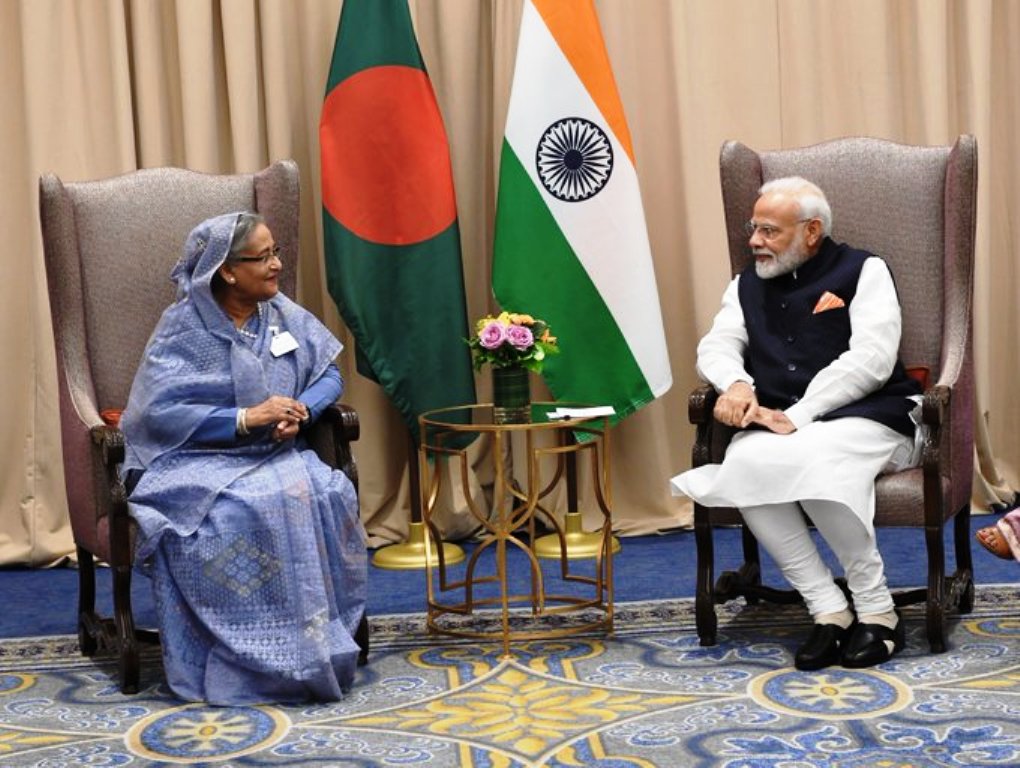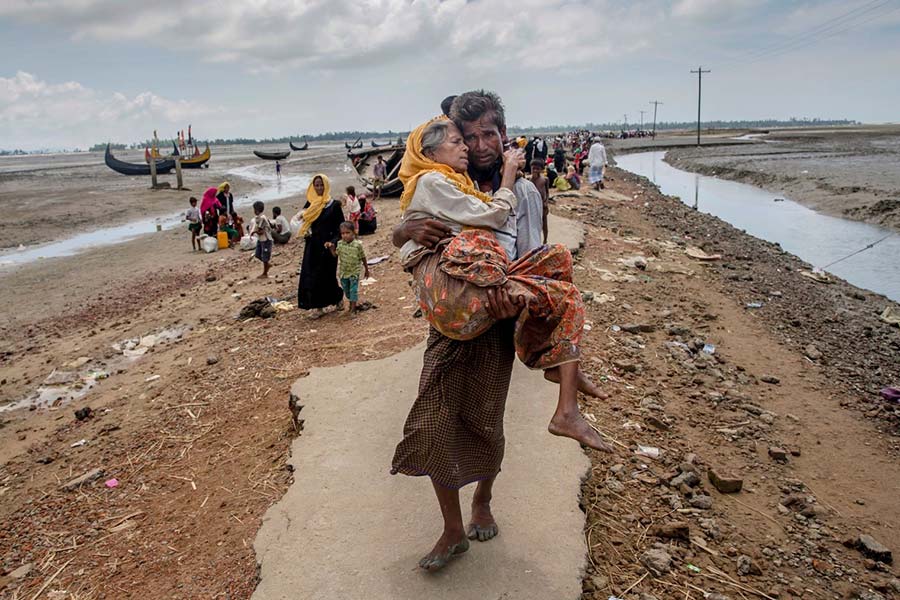by Syed Suhail Yaqoob
In India, Bangladesh was considered simply as a backyard of India. Now, it is trying to move away from India’s influence.

Bangladesh is an emerging impressive story. International organisations are all praise for its progress and development. The country has shown a tremendous capability to cope up with every circumstance.
In the ongoing Covid-19 pandemic, Dhaka has positive economic growth, quite unlikely as its neighbour like India showed a decline of -23 per cent contractions. Pakistan’s economic growth also contracted but its contraction was not so severe, however. The contraction will weigh in the image of India as it was a favourite destination for international investments. This must be very much worrying the policymakers in Delhi. The rise of Bangladesh visa viz India and Pakistan will change the geopolitical situation in the sub-continent forever.
The Rise
Bangladesh was started literally from the ruins. Caught in the vicious circle of violence particularly after its independence from erstwhile Pakistan it has come a long way. The country was poor, the growth rate was -14%, political instability was rife and the country was frequently devastated by floods and famine. The political instability was rife due to the killing of Sheikh Mujibur Rahman, its popular leader. Things have moved on. The country was growing with an average of 6% per annum.
Now, it is poised to surpass India’s per-capita income. According to IMF Bangladesh’s per-capita is US$ 1,888 whereas India’s is only US$1,877 a difference of one dollar which is likely to increase given the growth trends in both countries. The country has not only increased in economic growth but has also made sure that that economic growth is distributed equally. In most of the social indices like education, health and nutrition the country has scored better than India.
Even from a gender point of view, Bangladesh has outscored India. Women in the country enjoy better health, mortality and education status. In the country, the total fertility rate has declined below 2.5 births each woman implying increasing opportunities. Furthermore in the recent Global Hunger Index; India has ranked at 107 while Bangladesh is much ahead at 75. Even on the nutrition front, the country has fared better than its neighbours. Thirty-three per cent of Bangladeshi children are underweight compared to India’s 36 per cent as per demographic surveys. Almost in every social index, Bangladesh has left behind India.
Strategic Location
The country is to the east of India and is strategic for India’s national security. Indra Gandhi, the then Prime Minister, made sure that Bangladesh is detached from Pakistan in 1971 to secure its borders from the east. It is important to note that if Bangladesh would have remained a part of Pakistan, India’s national security would have been in jeopardy.
The disintegration of Pakistan in 1971 made sure that at least for time being India’s eastern borders remain largely peaceful. From 1971 the relations between Pakistan and Bangladesh have never been good partly due to allegations of a massacre by Pakistani troops.

However, the relations are likely to take a U-turn in future. Both countries will in future come on same plate-form owing to a number of factors prominent being rising middle class in Bangladesh, Chinese influence in the region and more importantly due to strategic blunders by the Indian government.
Bangladesh’s has around 40 million dynamic middle class. A simple look at the history books will reveal that the middle class usually look towards religion for identity. It will improve relations between Bangladesh and Pakistan in near future. The recent protests in Bangladesh against blasphemy are a case in point. People came in large numbers to protests which signal the trends in its society. Further, the rise in the use of mobile phones in Bangladesh (which is around 99% of its population) has increased its citizen awareness of the world especially of the sub-continent. The sub-continent is caught in communal tensions and no country will remain immune to it. There have been reports of communal tensions in the country.
China Impact
Moreover, the country has become important to China given its border issues with India. Both countries have locked horns in Ladakh and possibilities of a conflict can not be ruled out. Pakistan, Nepal and Sri Lanka are already in the ambit of China. The Chinese leadership is wooing Bangladesh off-late. A look at the sub-continents map will reveal that China will do everything to keep Bangladesh closer to it and strain its relations with India.
China has already exempted 97 per cent of Bangladesh’s good from tariff’s thus nudging it from India’s space. More worrying for India is Beijing’s investment in the country. China has emerged as Bangladesh’s largest development partner in recent years and has pumped in funds for several infrastructure projects.

During Xi’s Dhaka visit in 2016, the two countries had signed MoUs for implementing several infrastructure projects worth over US$ 25bn. According to The Diplomat, Chinese investment plans announced in October 2016 included 27 MoUs, valued at US$ 24bn while Chinese and Bangladeshi companies separately entered 13 joint ventures valued at US$ 13.6 bn. China now wants Bangladesh to participate in the Belt and Road initiative which is surely an offer difficult to refuse. Bangladesh wants money and the former will be ready to provide it.
India is not in a position to provide loans as Bangladesh needs huge investment for sustaining its economic growth. The Indian economy has contracted by -23 per cent in 2020; a huge psychological dent. If Bangladesh falls into Chinese influence, India will be encircled. There is no doubt that if India doesn’t resort to friendly policy towards Bangladesh, it is sure to fall into the trap set by Chinese.
Dhaka-Delhi Relations
The relation is already reached low owing to NRC and CAA which is particularly aimed at Muslims. Unfortunately, CAA will push more Muslims into borders of Bangladesh which is already grappling with Rohingya crisis. The CAA has not so much strained the governmental relations but has impacted relations between citizens of both countries. The Chinese have been keeping an eye on the India-Bangladesh relations and have pounced on every opportunity.
The West has been lately trying to woo Bangladesh given its economy. US Secretary of State, Mike Pompeo, for instance, made a visit to the country which is seen a big thing vis a viz Pakistan. Some have interpreted it as a decline of Pakistan’s position in South-Asia.
Dhaka Islamabad Relations
At the same tie, however, the relations between Pakistan and Bangladesh are growing. It is astonishing to note that imports from Pakistan to Bangladesh have grown by 26 per cent over the years. Recently Pakistan’s Prime Minister, Imran Khan called his Bangladeshi counterpart Sheikh Hasina wherein they exchanged greetings discussed the flood and Covid-19 situations in both countries. The telephonic interaction between two prime ministers has intrigued New Delhi amid India-China tensions.
Several political pundits have guessed that improvement in the relations between the countries is around the corner rather than nose-diving as is predicted in India. Moreover, it is erroneously concluded that the rise of Bangladesh will impact Pakistan’s position in the subcontinent.
Pakistan is a nuclear country and has a strategic position in the South-Asia. It is important for Amerian interests in Afganisation. Why the USA is trying to woo Bangladesh is only owing to its economic position. However, China has already taken a lead here and already integrated Bangladesh’s economy. Further, there have been some voices in the European countries to boycott the exports from Bangladesh which will only be another opportunity for China to exploit. It is important to note that Bangladesh is an export-oriented economy largely driven by export of textiles.

In India, Bangladesh was considered simply as a backyard of India. Now, it is trying to move away from India’s influence. The growing economy is likely to increase its confidence to move ahead independently in its foreign policy. The countries foreign policy has largely been India centric; there will be a shift in it in the near future.
Bangladesh is already spending a huge amount of money on the arms and ammunition. In 2019, the import of arms to Bangladesh amounted to the US $734 million. This was a dramatic increase from the previous year, in which arms imports amounted to approximately US $149 million. It is a coincidence that the country’s biggest supplier of arms is China. The country is procuring almost 80% of arms from China.
The crisis between India and Bangladesh is around the corner. The worst situation will be China, Pakistan and Bangladesh ganging up to pressurise India for one or the other reasons.
(The author is pursuing PhD at Aligarh Muslim University in Economics with a focus on gender. The opinions expressed in this article are those of the author’s and do not purport to reflect the opinions or views of Kashmir Life.)















